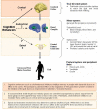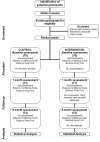Can cognitive enhancers reduce the risk of falls in older people with mild cognitive impairment? A protocol for a randomised controlled double blind trial
- PMID: 19674471
- PMCID: PMC3224736
- DOI: 10.1186/1471-2377-9-42
Can cognitive enhancers reduce the risk of falls in older people with mild cognitive impairment? A protocol for a randomised controlled double blind trial
Abstract
Background: Older adults with cognitive problems have a higher risk of falls, at least twice that of cognitively normal older adults. The consequences of falls in this population are very serious: fallers with cognitive problems suffer more injuries due to falls and are approximately five times more likely to be admitted to institutional care. Although the mechanisms of increased fall risk in cognitively impaired people are not completely understood, it is known that impaired cognitive abilities can reduce attentional resource allocation while walking. Since cognitive enhancers, such as cholinesterase inhibitors, improve attention and executive function, we hypothesise that cognitive enhancers may reduce fall risk in elderly people in the early stages of cognitive decline by improving their gait and balance performance due to an enhancement in attention and executive function.
Method/design: Double blinded randomized controlled trial with 6 months follow-up in 140 older individuals with Mild Cognitive Impairment (MCI). Participants will be randomized to the intervention group, receiving donepezil, and to the control group, receiving placebo. A block randomization by four and stratification based on fall history will be performed. Primary outcomes are improvements in gait velocity and reduction in gait variability. Secondary outcomes are changes in the balance confidence, balance sway, attention, executive function, and number of falls.
Discussion: By characterizing and understanding the effects of cognitive enhancers on fall risk in older adults with cognitive impairments, we will be able to pave the way for a new approach to fall prevention in this population. This RCT study will provide, for the first time, information regarding the effect of a medication designed to augment cognitive functioning have on the risk of falls in older adults with Mild Cognitive Impairment. We expect a significant reduction in the risk of falls in this vulnerable population as a function of the reduced gait variability achieved by treatment with cognitive enhancers. This study may contribute to a new approach to prevent and treat fall risk in seniors in early stages of dementia.
Trial registration: The protocol for this study is registered with the Clinical Trials Registry, identifier number: NCT00934531 http://www.clinicaltrials.gov.
Figures




References
-
- Third Canadian Consensus Conference on Diagnosis and Treatment of Dementia. http://www.cccdtd.ca/pdfs/Final_Recommendations_CCCDTD_2007.pdf
-
- Tinetti ME, Speechley M, Ginter SF. Risk factors for falls among elderly persons living in the community. N Engl J Med. 1988;319:1701–1707. - PubMed
Publication types
MeSH terms
Substances
Associated data
LinkOut - more resources
Full Text Sources
Other Literature Sources
Medical

